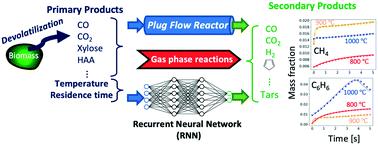当前位置:
X-MOL 学术
›
React. Chem. Eng.
›
论文详情
Our official English website, www.x-mol.net, welcomes your
feedback! (Note: you will need to create a separate account there.)
A recurrent neural network model for biomass gasification chemistry
Reaction Chemistry & Engineering ( IF 3.4 ) Pub Date : 2021-11-17 , DOI: 10.1039/d1re00409c Krishna Gopal Sharma 1 , Niket S. Kaisare 2 , Himanshu Goyal 2
Reaction Chemistry & Engineering ( IF 3.4 ) Pub Date : 2021-11-17 , DOI: 10.1039/d1re00409c Krishna Gopal Sharma 1 , Niket S. Kaisare 2 , Himanshu Goyal 2
Affiliation

|
Detailed chemical kinetic models involving hundreds of species and thousands of reactions have recently been developed for biomass thermochemical conversion. The high computational cost of these kinetic models makes them impractical even for simple reactor geometries. In this work, we develop a recurrent neural network (RNN) model for the secondary gas-phase reactions of biomass gasification in an inert environment in the temperature range of 800–1000 °C. A gated recurrent unit (GRU) based RNN architecture is used to ensure accurate predictions over the entire range of time in the reactor. A compact kinetic model reduced from a detailed kinetic scheme using an automated reduction algorithm is employed as the reference kinetic scheme for the gas-phase reactions. A comprehensive range of biomass compositions and reactor conditions are used to generate the training data ensuring a wide range of the model applicability. The developed GRU-based RNN model can predict the temporal evolution of important reactants and products during biomass gasification in the freeboard region of a fluidized bed reactor. The model reduces the computational cost associated with the reference kinetic scheme by four orders of magnitude.
中文翻译:

生物质气化化学的递归神经网络模型
最近已经为生物质热化学转化开发了涉及数百种物质和数千种反应的详细化学动力学模型。这些动力学模型的高计算成本使它们即使对于简单的反应器几何形状也不切实际。在这项工作中,我们开发了一个循环神经网络 (RNN) 模型,用于在 800-1000 °C 的温度范围内在惰性环境中进行生物质气化的二次气相反应。基于门控循环单元 (GRU) 的 RNN 架构用于确保在反应器中的整个时间范围内进行准确预测。使用自动还原算法从详细动力学方案简化的紧凑动力学模型用作气相反应的参考动力学方案。使用全面的生物质成分和反应器条件来生成训练数据,确保模型的广泛适用性。开发的基于 GRU 的 RNN 模型可以预测流化床反应器干舷区域生物质气化过程中重要反应物和产物的时间演变。该模型将与参考动力学方案相关的计算成本降低了四个数量级。
更新日期:2021-11-30
中文翻译:

生物质气化化学的递归神经网络模型
最近已经为生物质热化学转化开发了涉及数百种物质和数千种反应的详细化学动力学模型。这些动力学模型的高计算成本使它们即使对于简单的反应器几何形状也不切实际。在这项工作中,我们开发了一个循环神经网络 (RNN) 模型,用于在 800-1000 °C 的温度范围内在惰性环境中进行生物质气化的二次气相反应。基于门控循环单元 (GRU) 的 RNN 架构用于确保在反应器中的整个时间范围内进行准确预测。使用自动还原算法从详细动力学方案简化的紧凑动力学模型用作气相反应的参考动力学方案。使用全面的生物质成分和反应器条件来生成训练数据,确保模型的广泛适用性。开发的基于 GRU 的 RNN 模型可以预测流化床反应器干舷区域生物质气化过程中重要反应物和产物的时间演变。该模型将与参考动力学方案相关的计算成本降低了四个数量级。











































 京公网安备 11010802027423号
京公网安备 11010802027423号